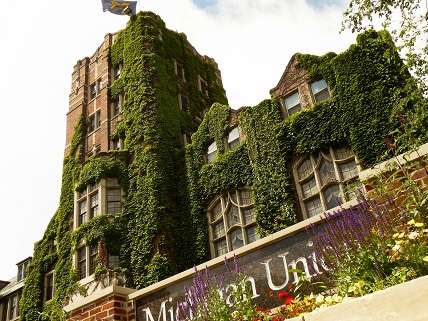Students Newspapers Desecrating Free Speech: A Transformation, or Return to Form?
The cycle of censorship rears its ugly head.


Everybody is buzzing about Jonathan Chait's latest feature for New York magazine, which argues that the culture of repressive political correctness on college campuses has returned in full-force after a period of hibernation following its peak in the 80s and early 90s. Responses to the article, wrote Reason contributor and Cato Institute scholar Julian Sanchez on Twitter, "make me wonder if Chait hired a team of satirists to underscore his point."
In his article, Chait pursues many of the usual campus suspects: trigger warnings, microaggressions, etc. Readers will not be surprised to learn that I share many of Chait's concerns, having written about them extensively myself.
I have also covered the incident that Chait chose as the launching point for his article:
Around 2 a.m. on December 12, four students approached the apartment of Omar Mahmood, a Muslim student at the University of Michigan, who had recently published a column in a school newspaper about his perspective as a minority on campus. The students, who were recorded on a building surveillance camera wearing baggy hooded sweatshirts to hide their identity, littered Mahmood's doorway with copies of his column, scrawled with messages like "You scum embarrass us," "Shut the fuck up," and "DO YOU EVEN GO HERE?! LEAVE!!" They posted a picture of a demon and splattered eggs.
This might appear to be the sort of episode that would stoke the moral conscience of students on a progressive campus like Ann Arbor, and it was quickly agreed that an act of biased intimidation had taken place. But Mahmood was widely seen as the perpetrator rather than the victim. His column, published in the school's conservative newspaper, had spoofed the culture of taking offense that pervades the campus. Mahmood satirically pretended to denounce "a white cis-gendered hetero upper-class man" who offered to help him up when he slipped, leading him to denounce "our barbaric attitude toward people of left-handydnyss." The gentle tone of his mockery was closer to Charlie Brown than to Charlie Hebdo.
The Michigan Daily, where Mahmood also worked as a columnist and film critic, objected to the placement of his column in the conservative paper but hardly wanted his satirical column in its own pages. Mahmood later said that he was told by the editor that his column had created a "hostile environment," in which at least one Daily staffer felt threatened, and that he must write a letter of apology to the staff. When he refused, the Dailyfired him, and the subsequent vandalism of his apartment served to confirm his status as thought-criminal.
Mahmood's treatment hit close to home for Chait, who also attended the University of Michigan and wrote articles for The Michigan Daily that landed him in trouble with the forces of political correctness in the early 90s. Chait writes that what happened to Mahmood "would not have shocked anybody familiar with the campus scene from two decades earlier."
Like Chait, I am also a U-M grad and former Michigan Daily scribe. My experience, however, was remarkably different from his and Mahmood's. When I edited the student newspaper's opinion page in 2009, I worked alongside writers who generally took a traditionally liberal approach to discourse and held that the answer to bad speech was more speech. The paper employed humor columnists and did not routinely balk at the idea of publishing controversial opinions.
In the years since, The Michigan Daily op-ed page has transformed itself into little more than a propaganda outlet for Marxist-inspired social justice thinking; the online opinion section runs a constant stream of first-person narratives offering tired perspectives on race, gender, and sexuality. This deliberate effort, packaged as "Michigan in Color," is an endless parade of trigger warnings, microaggressions, and the like. From a free speech perspective, the content is not the problem; news outlets should feel free to run whatever they like—that's the whole point. But all too often, people who hold the far-left perspective on these issues are willing to resort to censorship to protect their positions. And so a newsroom culture beholden to trigger warnings and microaggressions will unsurprisingly produce the conditions that led to Mahmood's firing.
The transformation at The Michigan Daily is disheartening to this former staffer whose journalistic career was born inside its office. But according to Chait's account, what has happened there is not so much a transformation as it is a return to form after the aberration that occured during my time there.
If so, there are likely two factors at play. For one thing, college newspapers have high staff turnover rates, since students eventually graduate and leave the paper. Most writers are only with their college dailies for a year, or two, or three. So it's easy for the institutional culture to change rapidly.
The other factor is that respect for free speech on campus—and everywhere else—seems to be cyclical. I first came to campus in 2006, at the height of anti-Bush sentiment. Republicans were ascendant for years, and liberals had grown accustomed to being part of a political minority. At the time, the right to dissent was a necessity for young leftists, and so part of their mantra concerned allowing voices that clashed with those in power to speak, airing perspectives contrary to the mainstream, etc. But as liberalism's fortunes changed, free speech ceased being a priority or a useful tool for the activist left.
The tragic result is that more and more students—and not just the journalists—now expect "freedom from speech," as Foundation for Individual Rights in Education President Greg Lukianoff put it.


Show Comments (89)